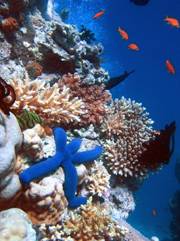Definition
Biodiversity is the variation of life forms within a given ecosystem, biome, or for the entire Earth. Biodiversity is often used as a measure of the health of biological systems. The biodiversity found on Earth today consists of many millions of distinct biological species, which is the product of nearly 3.5 billion years of evolution.
The current textbook definition of "biodiversity" is "variation of life at all levels of biological organization

Some of the biodiversity of a coral reef
Biologists most often define "biological diversity" or "biodiversity" as the "totality of genes, species, and ecosystems of a region". An advantage of this definition is that it seems to describe most circumstances and present a unified view of the traditional three levels at which biological variety has been identified:
- Genetic diversity
- Species diversity
- Ecosystem diversity
Genetic diversity
Genetic diversity is a level of biodiversity that refers to the total number of genetic characteristics in the genetic makeup of a species. It is distinguished from genetic variability, which describes the tendency of genetic characteristics to vary.
Agricultural relevance
When humans initially started farming, they used selective breeding to pass on desirable traits of the crops while omitting the undesirable ones. Selective breeding leads to monocultures: entire farms of nearly genetically identical plants. Little to no genetic diversity makes crops extremely susceptible to widespread disease. Bacteria morph and change constantly. When a disease causing bacterium changes to attack a specific genetic variation, it can easily wipe out vast quantities of the species. If the genetic variation that the bacterium is best at attacking happens to be that which humans have selectively bred to use for harvest, the entire crop will be wiped out.
A very similar occurrence is the cause of the infamous Potato Famine in Ireland. Since new potato plants do not come as a result of reproduction but rather from pieces of the parent plant, no genetic diversity is developed, and the entire crop is essentially a clone of one potato, it is especially susceptible to an epidemic. In the 1840s, much of Ireland’s population depended on potatoes for food. They planted namely the “lumper” variety of potato, which was susceptible to a rot-causing plasmodiophorid called Phytophthora infestans. This plasmodiophorid destroyed the vast majority of the potato crop, and left tens of thousands of people to starve to death.
Coping with poor genetic diversity
The natural world has several ways of preserving or increasing genetic diversity. Among oceanic plankton, viruses aid in the genetic shifting process. Ocean viruses, which infect the plankton, carry genes of other organisms in addition their own. When a virus containing the genes of one cell infects another, the genetic makeup of the latter changes. This constant shift of genetic make-up helps to maintain a healthy population of plankton despite complex and unpredictable environmental changes.
Cheetahs are a threatened species. Extremely low genetic diversity and resulting poor sperm quality has made breeding and survivorship difficult for cheetahs – only about 5% of cheetahs survive to adulthood. About 10,000 years ago, all but the jubatus species of cheetahs died out. The species encountered a population bottleneck and close family relatives were forced to mate with each other, or inbreed. However, it has been recently discovered that female cheetahs can mate with more than one male per litter of cubs. They undergo induced ovulation, which means that a new egg is produced every time a female mates. By mating with multiple males, the mother increases the genetic diversity within a single litter of cubs.
Measures of genetic diversity
Genetic Diversity of a population can be assessed by some simple measures.
- Gene Diversity is the proportion of polymorphic loci across the genome.
- Heterozygosity is the mean number of individuals with polymorphic loci.
- Alleles per locus is also used to demonstrate variability.
Species diversity
Species diversity is an index that incorporates the number of species in an area and also their relative abundance. It is generally a much more useful value than species richness.
The most common index of species diversity is a family of equations called Simpson's Diversity Index.
Here is one such example
D = (n / N)2
Where n is the total number of organisms of a particular species and N is the total number of organisms of all species. D is the value of diversity. It can range between 0 and 1, where 1 is the richest an Ecosystem can possibly be.
Humans have a huge effect on species diversity; the main reasons are:
- Destruction, Modification, and/or Fragmentation of Habitat
- Introduction of Exotic Species
- Over harvest
- Global Climate Change
Ecosystem diversity
Ecosystem diversity refers to the diversity of a place at the level of ecosystems. It is contrasted with biodiversity, which refers to variation in species rather than ecosystems. |

